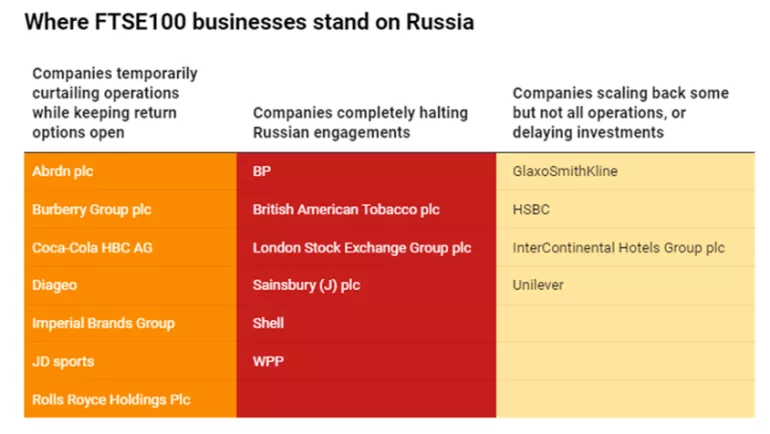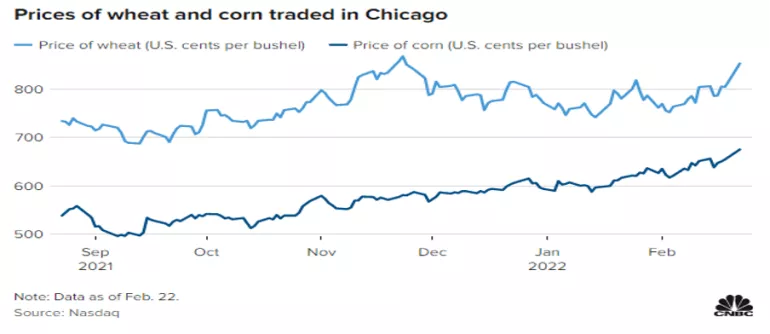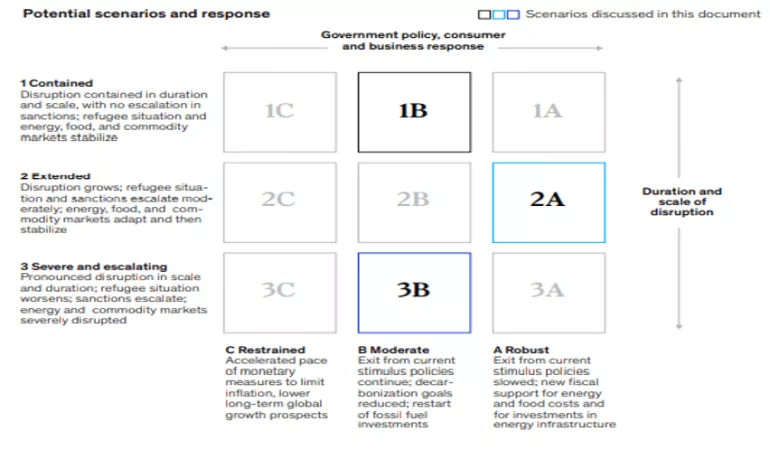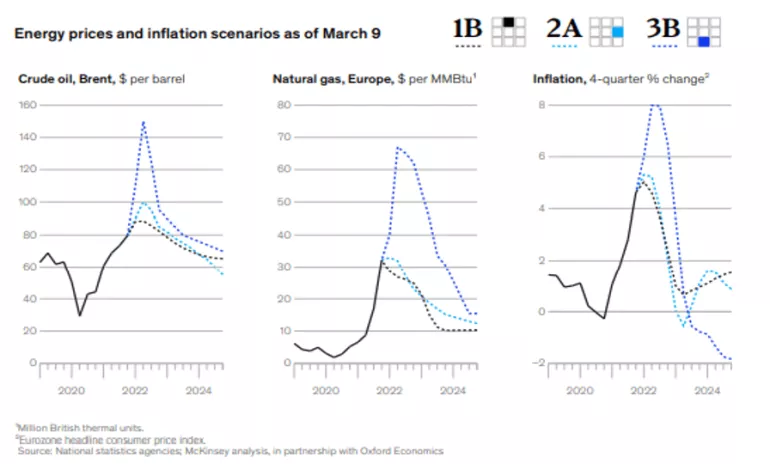Geopolitical Insights of Ukraine Russia Conflict on Supply Chains (Part 1)
Not a day goes by without more news about the ongoing conflict in the Ukraine, the ramifications of which will be felt across supply chains for months if not years to come. The impact will be direct and indirect relating to commodities and energy. Russia and Ukraine account for 29% of all the world's wheat exports, and Germany relies on Russian gas to power its electricity and energy grid by around 50%. The pursuit of billionaires in the Navalny 35 continues with the French seizing €850 million in a single day. Coordinated sanctions by many world governments are changing the dynamics of supply chains globally.
More than 400 companies globally have put distance between themselves and Russia according to research compiled and published by Yale School of Management. Yale has defined 5 categories of companies as follows:
-
WITHDRAWAL - Companies making a clean break and completely exiting Russia and halting all Russian engagements.
-
SUSPENSION - Companies temporarily curtailing operations while keeping return options open for return.
-
SCALING BACK - Companies reducing activities and scaling back some business operations while continuing others.
-
BUYING TIME - Companies holding off on new investments or developments and postponing future planned investments/developments/marketing while continuing substantive business.
-
DIGGING IN - Companies defying demands for exit or reduction of activities.
All this shows that the response has not been universal and different organizations will have different or competing motives for their actions. Procurement and supply chain leaders’ alignment with their organization’s strategy will be key in this area. However, it will need careful consideration in terms of immediate, short, and long term reputational consideration. This is both internal and external with some employees already posting comments about many companies via Glassdoor and their positions on their employers' responses.
Below is a perspective on the situation from the FTSE100 as of 21st March 2022:

Image credit: Torsten Asmus via Getty Images
London Stock Exchange
The London Stock Exchange has suspended trading in 28 companies to date with strong links to Russia, with more being investigated with secondary links. Some of the most notable are; Lukoil, Gazprom, EN+, and Rosneft, Russian bank Sberbank, Novolipetsk Steel, and Polyus, VTB Capital, a subsidiary of Russia’s second-largest bank VTB. This also extends to pension funds, securities and other investment vehicles.
BP
After spending 30 years building up its business, it took BP’s board just three days to accept a potential $25 billion loss by selling its stake in Rosneft, Russia’s state-owned gas company. BP battled with Putin’s corrupt oligarchy for years until it came to a working arms-length relationship. But the speed of withdrawal meant that even with that relationship, BP had a rapid exit strategy in place.
Renault
In contrast, car-maker Renault relies on the Russian market for 12% of its revenue through its majority stake in AvtoVAZ, which is both the largest car manufacturer in Russia and a partnership with the Russian state manufacturer of missiles, planes, and AK-47s, itself the subject of Western sanctions since 2014. The business partnership makes it expensive to pull out of the Russian economy and the loss of 37% of its value since the Russian invasion makes it expensive to stay. Renault is deeply enmeshed with actors in Putin’s war machine, and although it has paused some of its operations because of logistics problems caused by the sanctions, Renault appears to have had no real exit strategy or to have planned for such tough sanctions.
According to CNBC the downstream impacts could be summarized as follows:
-
Russia & Ukraine account for 29% of the worlds wheat exports.
-
Ukraine has replaced the U.S. as China’s top corn supplier in 2021
-
Russia and Ukraine are large suppliers of metals and other commodities.
-
Germany, along with the EU would be especially hit, especially in terms of energy supplies. Further, exports from Germany include autos and auto parts, other transport equipment, electronics, metals and plastics.
-
Oil and Gas prices are set to surge even further gas prices, but the impact on energy won’t be the only ramification.
-
Ukraine produces wheat, barley and rye that much of Europe & MENA relies upon, with a prolonged conflict likely to create bread shortages.
-
Wheat futures traded in Chicago have jumped about 12% since the start of this year, while corn futures spiked 14.5% in the same period.
-
Production of energy-intensive products such as fertilizers are likely to be short supply: Fertilizers were already in short supply last year, leading to soaring prices.
-
Russia controls about 10% of global copper reserves, and is a major producer of nickel (key raw material in batteries) and platinum.
-
The U.S. chip industry heavily relies on Ukrainian-sourced neon and Russia also exports a number of elements critical to the manufacturing of semiconductors, jet engines, automobiles and medicine.

Nickel
According to a variety of sources such as The Register, The Wall Street Journal, and Tech Crunch, the impacts across the supply chain will not only on price, but security of supply and regular flow of materials, all of which will have cash flow implications. For example, Nickel is a major component of the high nickel chemistry batteries (NCM 6, 7 and 8 series, NCA etc.) which is predominantly used in the U.S. and Europe. This could lead to stockpiling and serious price escalations as manufacturers struggle to keep production moving when you consider that Russia ranks third globally in terms of nickel production and, therefore, constrained nickel supplies is likely to slow down EV battery production.
Automotive Manufacturers
To compound the issue for automotive manufacturers (81% of total consumption) in particular, Russia is one of the largest producers of Palladium, accounting for around 35% of the global palladium production. Nornickel the largest palladium producing company located in Russia. Palladium prices have jumped by 37% since the start of year 2022, with likely increases and price volatility.
Sunflower Oil
Ukraine is the largest producer and exporter of sunflower oil accounting for 33% of global production and 50% of global exports. Export prices from the country reached $1550/MT on 24th February (+7% on the prior week). Since the start of conflict in February India has not received a single shipment of sunflower oil from Ukraine against an average import of 200,000 MT from the country per month. Further, a Cargill-chartered vessel was hit by a projectile in the Black Sea on 24th February who owns a majority stake in a deep-sea port near Odessa, Ukraine. Clearly cutting ties and stopping business for these types of operations is hugely complex.
Other Geopolitical Issues
What we should also not lose sight of is the fact that on the commencement of the Ukraine invasion, China immediately conducted air raids over Taiwan. Further heightening the geopolitical stability. However, the exposure to sanctions and trading is significantly lower in the Latin American countries due to pre-existing links and the fact that NATO is not connected with this region.
Ports
Lloyds Market Association has placed Ukrainian and Russian waters in the Black Sea and the Sea of Azov under a high-risk category with a full blockade of the ports in the Black sea expected. This has inevitably pushed up the insurance premiums for freight, further escalating the freight charges.There are currently a number of closed or restricted sea ports and airports:
-
Ports on the sea of Azov, include Taganrog, Mariupol, Yeysk and Berdyansk.
-
Federal Agency for Air Transport has closed airports in Russia, these closures are currently in force and under review.
-
The closures include airports in Rostov, Krasnodar, Anapa, Gelendzhik, Elista, Stavropol, Belgorod, Bryansk, Kursk, Voronezh, and Simferopol.
IT Exports
Ukraine’s IT export portfolio has increased by 36% to $6.8 billion in 2021, up from $5 billion in 2020 and $4.2 billion in 2019, according to the IT Ukraine Association. It is estimated that there are over 100,000 IT employees in software engineering and other IT services, with overall IT resources around 285,000 in Ukraine. The companies currently known to be associated/impacted are larger IT Service providers (EPAM, Intellias, Ciklum, ELEKS etc.) and IT centers of global Tech firms such as Google, Uber, Facebook.
Australia
On March 21, 2022, the Australian Prime Minister, Scott Morrison said they are making $243m on a critical minerals project to boost supply chain resiliency in an attempt to reduce the country’s reliance on China. This investment is set to create over 3,400 jobs and establish Australia’s place in the fast-growing critical minerals, electric vehicle, and battery markets as a result. However, this will take time to materialize like most capital investments and will not alleviate the immediate situation.
The Future
Looking at this from an economics and future perspective, as everyone would like a crystal ball at this moment in time, McKinsey’s recent paper (see resources below) in March 2022 set out three scenarios from the point of two critical dimensions:
- Scale and duration of the disruption
- The impact of government policy, consumer, and business responses.
This is illustrated in the diagram below:

This analysis then leads to how the economists think the energy prices and inflation are likely to play out in each of these 3 scenarios:

Additional Read: Geopolitical Insights of Ukraine Russia Conflict on Supply Chains (Part 2)
Resources
Russian asset tracker, The Navalny list of 35 individuals named last year by the jailed opposition leader Alexei Navalny (Guardian consortium with cross media investigative journalist group 7 support from the SFO) Russian Asset Tracker - OCCRP
Management today: https://www.managementtoday.co.uk/does-ftse-100-stand-russia/down-to-business/article/1750144
HBR: Are the Risks of Global Supply Chains Starting to Outweigh the Rewards? (hbr.org)
How the War in Ukraine Is Further Disrupting Global Supply Chains (hbr.org)
McKinsey: war-in-ukraine-lives-and-livelihoods-lost-and-disrupted.pdf (mckinsey.com)
When nothing is normal: Managing in extreme uncertainty (mckinsey.com)
in-conversation-managing-in-extreme-uncertainty.pdf (mckinsey.com)
Six problem-solving mindsets for very uncertain times (mckinsey.com)
building-value-chain-resilience-with-ai.pdf (mckinsey.com)
the-resilience-imperative-succeeding-in-uncertain-times.pdf (mckinsey.com)



